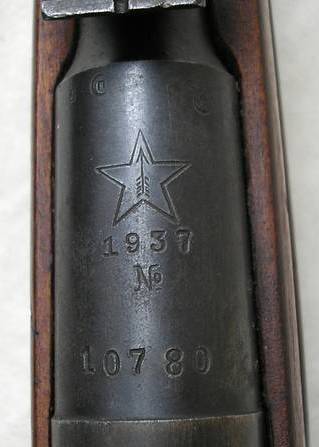Mosin Nagant History By Serial Number

Anyone know of a website that has Mosin Nagant serial #'s listed. Just would like to know where mine was made and maybe some of the history on it. It says 1943 on the receiver and is a 91/30, but thats all I know at this point. Also, the serial number is on the receiver, the bolt, bottom of the magazine, and on the butt plate. Anywhere else I should look? Any other marks to look for? Just an FYI, if you are seeing the 1943 date on top it's stamped on the barrel, not the receiver.
If it's a Russian Mosin it can only be either a Tula (star) or an Izhevsk (triangle). The only other thing to check is the receiver date which is on the bottom of the rear tang of the receiver, but if it's a Russian refurb it's rare to see a date that doesn't match the barrel date. If it has a mark like this on the metal [ ] or like this on the wood [ ] that is a refurb mark. Just an FYI, if you are seeing the 1943 date on top it's stamped on the barrel, not the receiver.
If it's a Russian Mosin it can only be either a Tula (star) or an Izhevsk (triangle). The only other thing to check is the receiver date which is on the bottom of the rear tang of the receiver, but if it's a Russian refurb it's rare to see a date that doesn't match the barrel date. If it has a mark like this on the metal [ ] or like this on the wood [ ] that is a refurb mark. I think this is the receiver: I have not seen a dated barrel, but I have seen barrels with proof marks offset indicating it was replaced.
Covadis 9 1 Crack Beer. Feb 13, 2012 Hi all. I just bought a few Mosin-Nagant M91/30s. Is there any database on the internet that can should the individual history of each of them by serial number?
The Mosin Nagant has a long and bloody history. It’s served in rebellions, insurrections, both World Wars and has been in the hands of terrorists, freedom fighters, and hung on the mantels of people around the world. In 1889, the ruling Tsar declared that the Russian army would meet or exceed the rest of Europe in rifle technology. This meant implementing a smokeless powder cartridge, and a modern rifle design. Sergei Mosin, a designer at Tula arms manufacturing, and Belgian designer Leon Nagant paired together to create what we now know as the Mosin Nagant rifle. The Mosin-Nagant rifle was born in 1891 and was known as the 3 line rifle, model 1891.
The 3 line title comes from the line as a unit of measurement. A line is 1/10th of an inch.
This is a reference to the caliber of round it fires, a 30 caliber, which is 3/10ths of an inch. In 1904, the rifle saw its first real combat in the Russo-Japanese war. Here it well, but was not used extensively in combat. Between the Russo-Japanese war and World War 1, there was a variety of different models produced. All operated on the same action but differentiated in lengths, weight, and bayonet changes.
When World War one rolled around, manufacturing was limited to the shorter Dragoon and the standard infantry models. Russia could not produce enough rifles for the war, and contracted out to American arms manufacturing companies, Remington and Westinghouse. These American Mosins are somewhat collectible, and valued for their made in America status. The rifle fought in the bloody World War and proved itself to be extremely dependable. In 1930, the rifle was updated to make manufacturing quicker and more affordable. These modifications were slowly implemented and eventually produced the M91/30, the most common Mosin Nagant in the hands of shooters today.
In 1938, the M38 was adopted, it was a shorter version of the M91/30, and was not fitted for a bayonet. As World War two kicked off Russia found themselves short on firearms and in a rush to build rifles.
Wartime models are known for their rough finishes, and often featured tool marks and are generally ‘rougher’ in appearance than pre-war examples. Production continued during the war and a new carbine, featuring a side folding bayonet was created. This weapon was called the M44 and is another collector’s favorite. After World War 2 Russian production and development of the Mosin Nagant slowed and eventually ceased. This was done due to the development of the SKS rifle, which would lead to the AK 47 series as well. Communist countries around the world did produce a number of different Mosin clones, the most popular being the M44 carbine, produced in China as the Type 53. Today the Mosin Nagant still serves in numerous conflicts.
While it far from a standard issue weapon in most armies it’s not uncommon to find them across the world in the hands of poorly funded or guerilla armies. The rifle lives on as a popular choice for surplus collectors and those looking for something affordable, and fun to shoot. Next check out.